Notes: Numbers’ Magic | GK Olympiad for Class 3 PDF Download
| Table of contents |

|
| Introduction |

|
| Number Sense |

|
| Roman Numerals |

|
| Operations on Numbers |

|
| Length, Weight and Capacity |

|
| Money |

|
| Time |

|
| Calendar |

|
| Angles |

|
| Polygons |

|
| Data Handling |

|
| Patterns |

|
Introduction
Numbers are an important part of our life. Numbers are used for mathematical operations. The concepts of time and money can be understood with the help of numbers. The numbers can be expressed in the form of fractions, decimals, bar graphs, tally charts, etc. Various measurements of length, weight and capacity are made in terms of numbers.
Number Sense
- The largest three-digit number that can be created is 999.
- The place value of a digit is determined by its location within the number.
- The face value of a digit is simply the digit itself.
- Expressing a number as a total of the place values of its digits is called the expanded form of that number.
- Arranging numbers from the smallest to the largest is known as ascending order.
- Arranging numbers from the largest to the smallest is referred to as descending order.
- The successor of a number is the number that comes immediately after it.
- The predecessor of a number is the number that comes right before it.
- A number that can be paired up is called an even number.
- A number that cannot be paired is known as an odd number.
Roman Numerals
- The Roman numeral system consists of seven symbols – I, V, X, L,C,D, and M.
- In the Roman number system, there is no place value system.
- Each of the seven Roman numerals stands for a Hindu-Arabic numeral.

- L = 50, C = 100, D = 500, and M =1000
The other Roman numerals are formed using the following rules:
- Rule 1: If a letter is repeated, its value is added as many times as it is repeated.
- Rule 2: A letter of a smaller value, when written to the right of the letter of a bigger value, the smaller value is added to the bigger value.
- Rule 3: A letter of a smaller value, when written to the left of the letter of a bigger value, the smaller value is subtracted from the bigger value.
- Rule 4: If a letter of a smaller value is placed between two letters of a bigger value, then it is always subtracted from the letter of a bigger value on its right.
Operations on Numbers
- When two or more numbers are combined together to form a new number, it is called addition.
- The symbol used for addition is ‘+’.
- It is represented as
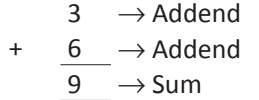
- Numbers must be arranged in columns of thousands, hundreds, tens the and ones.
- Addition always starts from the right side. First, we add ones, then tens, hundreds and so on.
Properties of Addition
- Additive Identity Property: When 0 is added to any number, Sum = The same number
- When 1 is added to any number, Sum = Successor of that number
- Order / Commutative Property: The order of the addends can be rearranged.
- Associative Property: If more than two numbers are to be added, any two numbers can be added first and the remaining number can be added to the sum calculated.
Subtraction
- When a smaller number is taken out from a larger number, it is called subtraction.
- The symbol used for subtraction is ‘ ’.
- It is represented as
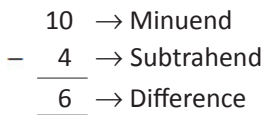
- Numbers must be arranged in columns of thousands, hundreds, tens and ones.
- Subtraction always starts from right side. First, we subtract ones, then tens, hundreds and so on.
- The bigger number is always written on top and smaller number below it.
Properties of Subtraction
- When 0 is subtracted from any number, Difference = The same number
- When 1 is subtracted from any number, Difference = Predecessor of that number
- When Minuend = Subtrahend, Difference = 0
Multiplication
- When two or more numbers or sets of numbers are added many times, it is called multiplication.
- The symbol used for multiplication is ‘×’.
- It is represented as
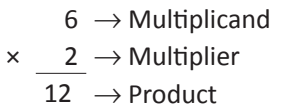
- Numbers must be arranged in columns of thousands, hundreds, tens and ones.
- Multiplication always starts from right side. First, we multiply ones, then tens, hundreds and so on.
Properties of Multiplication
- When any number is multiplied by 0, Product = 0
- When any number is multiplied by 1, Product = The same number
- Order / Commutative Property : The order of the multiplicand and multiplier can be rearranged.
- Associative Property : If more than two numbers are to be multiplied, any two numbers can be multiplied first and the remaining number can be multiplied with the product calculated.
Division
- When a number is to be distributed into equal groups, it is called division.
- The symbol used for division is ‘(1/3)’.
- Division always starts from the left side. First, we divide the leftmost digit and move towards right digits in each step.
Properties of Division
- When 0 is divided by any number, Quotient = 0 and Remainder = 0
- When any number is divided by 1, Quotient = Dividend
- When Dividend = Divisor, Quotient = 1 and Remainder = 0
Fractions
- When we divide an object in two equal parts, it is called one-half (1/2) of the whole.
- When we divide an object in three equal parts, it is called one-third (1/3) of the whole.
- The upper part of the fractions is called numerator. The lower part of the fraction is called denominator.

- If more than one part of a collection is shaded, then the fraction of shaded part is formed by keeping shaded parts as numerator and total parts as denominator.
Types of Fractions
- Like fractions: Fractions having same denominator

- Unlike fractions: Fractions having different denominators

- Proper fractions: Fractions having a numerator less than the denominator

- Improper fractions: Fractions having a denominator less than the numerator

- Mixed fractions: Fractions having whole number with a fraction

- Equivalent fractions: Fractions having same value

- Decimal fractions: Fractions with 10, 100, 1000,… as denominator

- Unit fractions: Fractions with 1 as a numerator

- To compare like fractions, we compare their numerators. The fraction with a smaller numerator is smaller and the fraction with a greater numerator is greater.
- To add like fractions, we simply add their numerator keeping the denominator in the fraction.
Decimals
- In a decimal number system, fractions or parts which are less than 1 are expressed in a special way.
- These are written using a decimal point which is represented by a (.).
- 1/10 is represented in decimals as 0.1.
- 1/100 is represented in decimals as 0.01.
- 1/1000 is represented in decimals as 0.001.
- Place Value chart of decimals

- The mixed fractions are expressed as decimals by changing the fractional part into decimal and placing a decimal between the whole number and fractional part.
Conversion of Decimals into Fractions
- Remove the decimal point.
- The number becomes the numerator.
- In the denominator, write 1 followed by the number of zeros equal to number of digits after decimal.
- Reduce the fraction into simple form.
Conversion of Fractions into Decimals
Fractions which have denominator as factor or multiple of 10, 100 or 1000:
- Change fractions: Convert fractions to equivalent fractions with denominators of 10, 100, or 1000.
- Improper fractions: Change an improper fraction into a mixed number.
- Decimal fractions: Convert proper or mixed fractions into decimal fractions.
- Like decimals: Decimal numbers with the same number of decimal places are called like decimals. Examples include:
- 9.65
- 18.54
- 0.21
- Unlike decimals: Decimal numbers that have different numbers of decimal places are known as unlike decimals. Examples are:
- 9.6
- 9.65
- 9.651
- Adding and subtracting like decimals:
- Arrange the numbers in columns so that digits in the same place line up.
- Begin adding or subtracting the numbers from the right side of the columns.
- If necessary, use regrouping.
- Adding and subtracting unlike decimals:
- Convert them into like decimals by adding zeros to the right end of the decimal.
- Align the numbers in columns so that digits in the same place are together.
- Start adding or subtracting from the right side of the columns.
- Use regrouping if needed.
Length, Weight and Capacity
- Some common things we can use to measure length are:

- Some common things we can use to measure weight are:
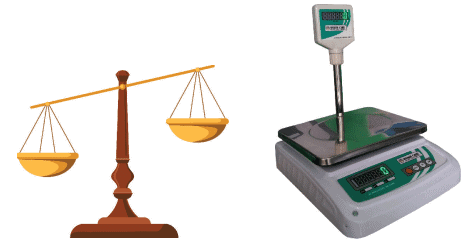
- Some common types of weights used are:
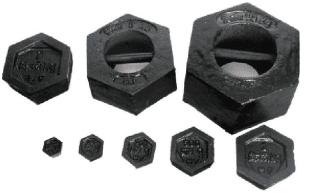
- Some common things we use to measure volume are:
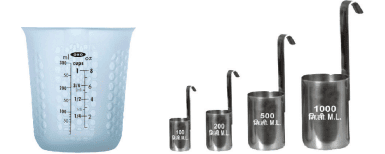

Money
- Different countries have different currencies.
- Rupee is the currency used in India as notes and coins.
Currency notes in circulation
Coins in circulation
- To represent rupees and paise together, a dot is used to separate rupees from paise. e.g., 2.50 here it is 2 rupees and 50 paise.
Time
To and Past in Time
- When the minute hand is in the right half of the clock, we say the minutes are Past.
- When the minute hand is in the left half, we say the minutes are To and the hour is the next hour.
Concept of Quarters
- Quarter past the hour: When the minute hand moves from 12 to 3, we say it is a quarter past the hour.
- Quarter to the hour: When the minute hand moves from 9 to 12, we say it is a quarter to the next hour.
Concept of a.m. and p.m.
- 12 o'clock at night is referred to as midnight. After this, the 12 hours of day begin.
- 12 o'clock in the day is known as noon. After this, the 12 hours of night start.
- The 12 hours of day are marked as a.m.. For example, 3 a.m., 7:15 a.m., etc.
- The 12 hours of night are marked as p.m.. For example, 4 p.m., 9:40 p.m., etc.
Conversion of units of time
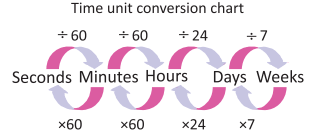
Calendar
- There are twelve months in a year – January, February, March, April, May, June, July, August, September, October, November and December.
- There are 365 days in a normal year.
- There are 366 days in a leap year.
- A leap year comes after every four years.
- There are 52 weeks in a year.
- There are seven days in a week – Monday, Tuesday, Wednesday,
- Thursday, Friday, Saturday and Sunday.
 Geometry
Geometry
2-D Shapes
- 2-D shapes are also called plane shapes.
- The five basic 2-D shapes are:


Solid Shapes
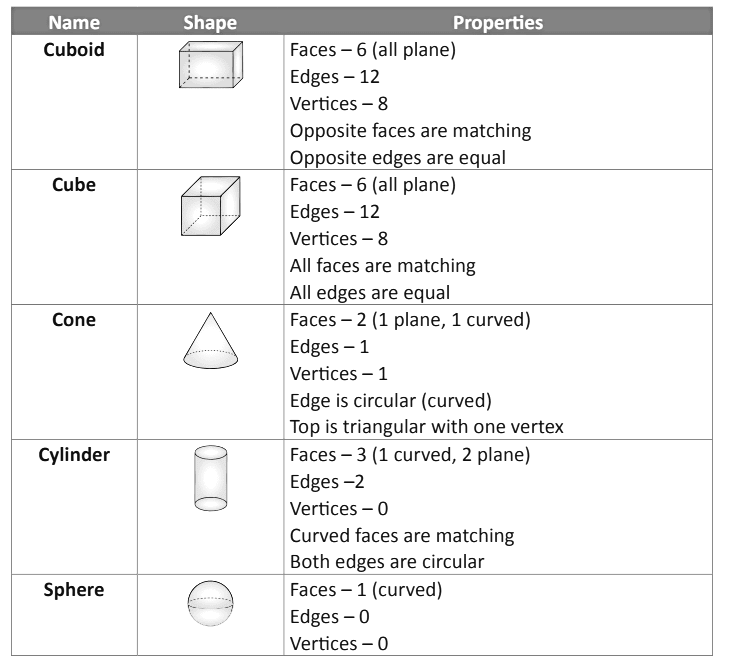
Basic Concepts of Geometry
- Point: A point is a specific location or position. In geometry, it is represented as a dot and is labeled with capital letters.
- Line Segment: A line segment is formed when two points are joined by a straight line. It is named after the two endpoints it connects.
- Line: A line extends infinitely in both directions and does not have a starting or ending point. It can be named using any two points that lie on it or by using lowercase letters. To indicate its direction, small arrows are drawn on both ends.
- Ray: A ray starts at a certain point but does not have an endpoint. It extends in only one direction. It is named using the starting point followed by any other point on the ray. A point marks the starting position, and an arrow shows the direction in which it extends.
Angles
An angle is a shape created when two rays come from the same point.
Types of Angles
- Acute angle: This angle measures more than 0° but less than 90°.
- Right angle: This angle measures exactly 90°.
- Obtuse angle: This angle is more than 90° but less than 180°.
- Straight angle: This angle measures exactly 180°.
- Reflex angle: This angle measures more than 180° but less than 360°.
- Complete angle: This angle measures exactly 360°.
Polygons
A polygon is a closed shape made by connecting three or more line segments.
Triangle
A triangle is a polygon formed by connecting three line segments. It has three sides, three corners (vertices), and three angles. There are three main types of triangles:
- Scalene triangle: This triangle has all three sides of different lengths.
- Isosceles triangle: This triangle has two sides that are the same length.
- Equilateral triangle: This triangle has all three sides of equal length.
- Quadrilateral: A quadrilateral is a shape made by connecting four line segments. It has four sides, four vertices, and four angles. Examples of quadrilaterals include a rectangle and a square.
- Pentagon: A shape formed by connecting five line segments is known as a pentagon. It consists of five sides, five vertices, and five angles.
- Hexagon: When six line segments are joined together, the resulting shape is called a hexagon. This shape has six sides, six vertices, and six angles.
- Heptagon: A shape created by connecting seven line segments is referred to as a heptagon. It features seven sides, seven vertices, and seven angles.
- Octagon: The polygon formed by joining eight line segments is called an octagon. An octagon has eight sides, eight vertices and eight angles.
Parallel and Intersecting Lines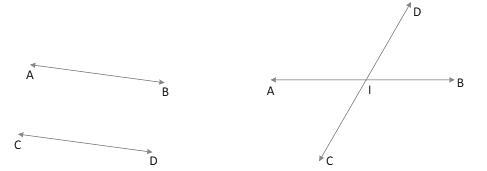
- Parallel lines: Parallel lines are at equal distance from each other at all the points. These lines do not cross each other even if they are extended in any direction.
- Intersecting lines: Intersecting lines cross each other at a point. Sometimes, these lines do not cross each other, but if we extend them in any direction, they cross each other.
Data Handling
Pictographs
- When data is presented and arranged in the form of pictures or symbols, it is called pictorial arrangement or pictograph.
- It is easy to understand pictographs as each picture or symbol represents a certain number of things. This is called Key of the pictograph.
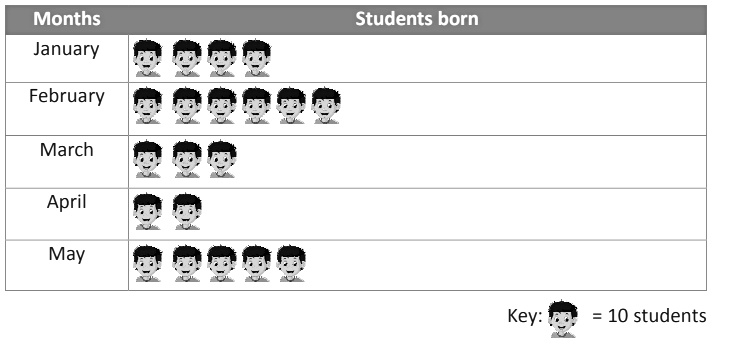
Bar Graphs
- A Bar Graph is used to represent given data by using bars of different heights.
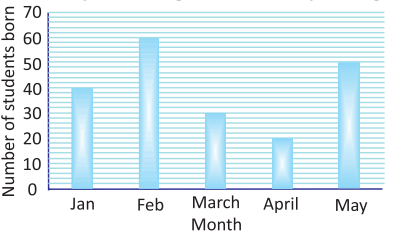
Collection of Data (Tally Marks)
- The collection of data can be presented in the form of Tally marks.
- Tally marks are drawing combination of vertical and diagonal lines to represent a number.
- To represent number 1 draw one vertical line,
- To represent number 4 draw four vertical lines,
- To represent number 5 draw four vertical lines and a diagonal line,
Patterns
Pattern is a list of numbers, letters or figures that follow a certain sequence of a certain rule.
Types of patterns:
- Number Pattern: Some numbers follow a particular addition, subtraction, multiplication, division or combination of these pattern.
- Letter Pattern: There are some letters of English alphabet which follow a particular rule.
- Figure Pattern: There are some figures which follow a particular rule. One of the missing figures in the set or next figure in the series is to be selected by understanding the rule followed by other figures.
|
44 videos|31 docs|44 tests
|
FAQs on Notes: Numbers’ Magic - GK Olympiad for Class 3
| 1. What is number sense and why is it important for Class 3 students? |  |
| 2. How do Roman numerals differ from the decimal system? |  |
| 3. What operations can be performed on numbers and how are they taught in Class 3? |  |
| 4. How can students better understand fractions and decimals in their studies? |  |
| 5. What are some common challenges students face in learning these number concepts? |  |















